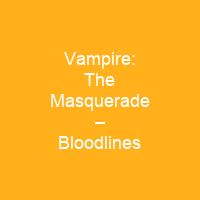Vampire: The Masquerade – Bloodlines is a 2004 action role-playing video game developed by Troika Games and published by Activision for Microsoft Windows. The game depicts the fledgling’s journey through the early 21st-century Los Angeles to uncover the truth behind a recently discovered relic. The player can select one of seven vampire clans: the powerful Brujah, the decadent Toreador, the insane Malkavian, the aristocratic Ventrue, the monstrously-deformed Nosferatu, and the blood-magic wielding Tremere.
About Vampire: The Masquerade – Bloodlines in brief

The team were left without a producer for nearly a year until Activision appointed David Mullich to the role, where he found designs and levels unfinished or abandoned. It is based on White Wolf Publishing’s World of Darkness, and follows a human who is killed and revived as a fledgling vampire. Players create a male or female vampire character by selecting a vampire clan and configuring available points in three areas— Attributes, Abilities and Disciplines —or by answering questions, which create a character for the player. The points spent on Attributes and Abilities combine to determine a player’s success or effectiveness in performing tasks such as using firearms, brawling, and lock-picking; for example, determining how accurate or how far the player can shoot, or if they can hack a computer. Each upgrade costs one point, and the upgrade cost increases as the game progresses. The player is initially assigned points to spend in the three areas, with the amount they can spend determined by clan; forexample, the Brujah can spend the most points on physical and skill attributes. It is impossible to accrue enough experience points to complete every skill. Experience points are gained by completing quests, finding items or unlocking secret paths, rather than killing enemies.
You want to know more about Vampire: The Masquerade – Bloodlines?
This page is based on the article Vampire: The Masquerade – Bloodlines published in Wikipedia (as of Dec. 07, 2020) and was automatically summarized using artificial intelligence.







